How are the spores and pollen grains transported ?
![]() The spermatophytes (conifers and flowering plants) generally have to send their pollen to other individuals of the same species. Two main strategies are used to transport the pollen : the insects and the wind.
The spermatophytes (conifers and flowering plants) generally have to send their pollen to other individuals of the same species. Two main strategies are used to transport the pollen : the insects and the wind.
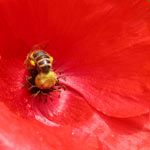

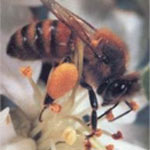
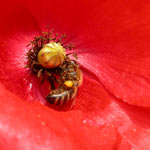
Entomophilous species often have attractive flowers (brightly coloured, with nectar), sometimes with special adaptations favouring contact between insects and stamens and stigmas.
As the insect probes for nectar, its body rubs against the stamens; pollen gets stuck on its hairs and legs. When the insect visits another flower, part of this pollen will stick to the stigmas. In particular, honey bees have pollen baskets on their hind legs where they can gather pollen. During transport, part of the pollen grains can be lost in the air and fall onto the ground.
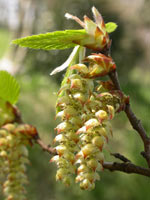
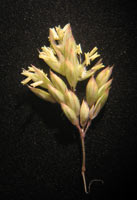
Anemophilous species are usually small and not showy. Wind-transported pollen is dispersed all around, so that only a small part of the produced pollen will reach the female organs of another individual of the same species. This constraints anemophilous species to produce a lot of pollen in order to have a chance of fertilization, but a large part of it will eventually fall onto the ground.
Anemophilous species usually produce lightweight pollen grains, which enables them to be dispersed over long distances (several kilometers and sometimes far more).
![]() Pteridophytes (ferns) release their spores by the opening of sporangia; spores simply fall onto the ground or are dispersed by air movements (or water movements in the case of aquatic ferns).
Pteridophytes (ferns) release their spores by the opening of sporangia; spores simply fall onto the ground or are dispersed by air movements (or water movements in the case of aquatic ferns).
![]() Bryophytes (mosses and liverworts) release their spores by the opening of capsules; spores usually fall onto the ground near the sporophyte, but can also be somewhat dispersed by wind.
Bryophytes (mosses and liverworts) release their spores by the opening of capsules; spores usually fall onto the ground near the sporophyte, but can also be somewhat dispersed by wind.
See also :
What does the pollen rain represent ?
Which are the deposits containing fossil spores and pollens ?